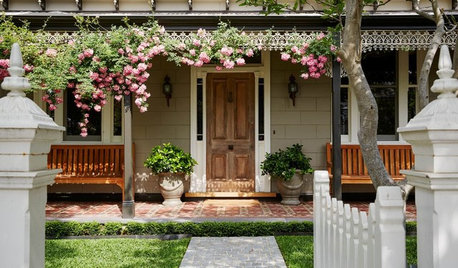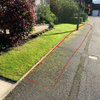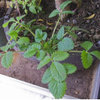How thick of a mulch does it take to keep down black medic, dandelions, and other common weeds? Can I put mulch down without pulling the weeds first? I'm on the verge of getting carpal tunnel syndrome from weeding so much. I can't keep wasting my time doing things that are inefficient, ineffective, or downright counterproductive.
You could say that my major problem is that my flower border is too big, at about 4,000 square feet. Reducing it to half or a quarter would help, but I still like the way it looks and want it this size, so I'm trying to salvage the situation. I've planted six trees and ten shrubs so far and would like to double or triple those numbers eventually. My purpose for this garden is to create a habitat for birds, bees, butterflies, moths, etc.
In 2011 when I started this garden where nothing but lawn had been, I sowed cover crop seeds. I didn't weed that year, and the next spring I chopped it all down and put it in the compost pile. I'm sure a lot of weed seeds, particularly black medic, got into the soil that year. According to this web page (http://www.sare.org/Learning-Center/Books/Managing-Cover-Crops-Profitably-3rd-Edition/Text-Version/Legume-Cover-Crops/Medics), black medic can produce three crops of seeds per year, the seeds can remain viable for twenty years, they can germinate in three days, and the most germination is in the fourth year after they're "sowed." This explains why I was able to keep up with the weeding in 2012 and just barely in 2013 but I'm losing the battle this year. In many places there are many black medic plants per square foot and they're growing so thickly that they stand up, supported by each other, rather than sprawl on the ground.
Dandelions are my second major weed problem this year. I use a dandelion fork but never seem to get the whole root, so a couple weeks after finishing weeding and mulching a bed, it's full of little dandelions, seemingly every single one I pulled out.
I've been reading the GardenWeb forums archives for five years, and I've learned a lot. But apparently I've been in denial about how much mulch it takes to block sunlight from hitting the native soil. I tried half an inch; that just made the weeds healthier. I tried an inch; that just maybe slowed them down a tiny bit. Obviously I need to try at least two inches. Do you think that will do it? I've read that more than three inches is too much, so I hope there is an upper limit at some point. Each inch will cost me $1,000, which explains why I haven't been putting enough of it down.
I didn't mulch in 2012, 2013, and earlier this summer because I had sowed 1.5 million flower seeds, most of them native wildflowers that can take up to two years to germinate. I had great germination of lupines in 2012, so there's a lupine about every square foot. Some (disappointingly few) of the 130 or so other species that I sowed last May, last December, and this May germinated and are hidden among the weeds.
I now realize that my bare native soil must be treated as if it were radioactive waste or flesh-eating bacteria. It is and always will be so full of weed seeds that it must never be allowed to see the light of day. Now, after I weed an area, I mix half compost and half sphagnum moss and sprinkle that just thickly enough that I can't see the soil. Then I dump as much "Soil Pep" (partially composted pine bark fines) as I can over that, but it's probably not even an inch in all places. I even dump it over the top of the lupines, because many weeds grow right inside lupine clumps. If I pull a weed from an already mulched area, I try not to let any native soil drop on the mulch, and I add some more mulch.
Before I started mulching, I had weeded about three-quarters of the beds, and all of the weeds came back with a vengeance in two or three weeks. I've weeded and mulched about a quarter of the beds since then. Now I've been told that I'm right on the edge of having carpal tunnel syndrome and I have to stop hand-weeding for a while.
I use "small western bark" on the paths, which I like, so if I were to start using something like that on the beds, I'd have to switch to something else for the paths so there would be a contrast.
Ironically, although I needs many cubic yards of expensive mulch, I already many cubic yards of partially composted yard debris that I'm afraid to use, four huge piles of stuff. Three piles are layers of pulled weeds and grass clippings. The other pile is spent lupine plants. The piles take about year, more or less, to decompose in place. I also have five compost containers that rotate, which produce finer compost from food scraps, leaves, and grass. When I've put the compost on the ground in the past, hundreds of weeds sprouted in those spots. So I've been using the more finished compost to cover the rougher piles before winter, so that they look like berms of soil to the neighbors. They've become places to dispose of excess materials, but I haven't been able to spread this stuff around to shade out weeds, because it would just create more weeds. (Sometimes the grass clippings have Weed-B-Gon in them as well.)
I could spread chopped lupine plants around as a mulch, but only in the areas that they grew in, because I'm trying to keep different colors of lupines in separate areas. Should I try that? One drawback is that the lupines have powdery mildew, and I've read that you should remove mildewy vegetation before the winter.
At this point I've finished hand-weeding one area (out of seven), and I'm trying to finish another and weed one more by September 9, when I want to sow seeds in those three areas. I bought a border fork to loosen up the soil before I weed, and I water it heavily as well. I'll add a little compost on top of the mulch and sow in that. Will that work?
I've given up on weeding the other four areas this year. Those areas are so thick with lupines that there isn't room for any other flowers. When the lupines turn brown I'm planning to weed-whack everything, rake it up, put it on the compost pile, and dump a bunch of mulch on the beds. Do you think this will work to suppress weeds?
I had a soil test done in 2011: pH 7.5, adequate fertility and organic matter. Clay loam, good drainage, good texture, dark color, lots of worms and insects.
These are the weeds I've identified (from Weeds of the West, University of Wyoming, 2012, 640 pages), in order of how numerous they are:
black medic (Medicago lupulina), annual or short-lived perennial
dandelion (Taraxacum officinale), perennial
prickly lettuce (Lactuca serriola), biennial
wild mustard (Sinapis arvensis), annual
common groundsel (Senecio vulgaris), annual or biennial
wild buckwheat (Polygonum convolvulus), annual
netseed lambsquarters (Chenopodium berlandieri), annual
Canada thistle (Cirsium arvense), perennial
western salsify (Tragopogon dubius), biennial
tumble pigweed (Amaranthus albus), annual
wild oat (Avena fatua), annual
large crabgrass (Digitaria sanguinalis), annual
annual bluegrass (Poa annua), annual
rattail fescue (Vulpia myuros), annual
shepherd's purse (Capsella bursa-pastoris), annual
tumble mustard (Sisymbrium altissimum), annual
field pennycress (Thlaspi arvense), annual
yellow sweetclover (Melilotus officinalis), annual or biennial
hemp dogbane (Apocynum cannabinum), perennial
redstem filaree (Erodium cicutarium), biennial
common chickweed (Stellaria media), annual
broadleaf plantain (Plantago major), perennial
hairy vetch (Vicia villosa), annual
spotted knapweed (Centaurea stoebe), biennial or short-lived perennial
common mullein (Verbascum thapsus), biennial
Here is a link that might be useful: Medics


















Kimmsr
myrmayde Zone 5b, western MontanaOriginal Author
Related Professionals
Wrentham Landscape Architects & Landscape Designers · Glassmanor Landscape Architects & Landscape Designers · Saint Charles Landscape Architects & Landscape Designers · Vernon Hills Landscape Architects & Landscape Designers · Norwood Landscape Contractors · Concord Landscape Contractors · Battle Ground Landscape Contractors · Golden Landscape Contractors · Goodlettsville Landscape Contractors · Lake Zurich Landscape Contractors · Nashua Landscape Contractors · Vancouver Landscape Contractors · Waltham Landscape Contractors · New Carrollton Landscape Contractors · Ferguson Landscape Contractorslisanti07028
myrmayde Zone 5b, western MontanaOriginal Author
Kimmsr